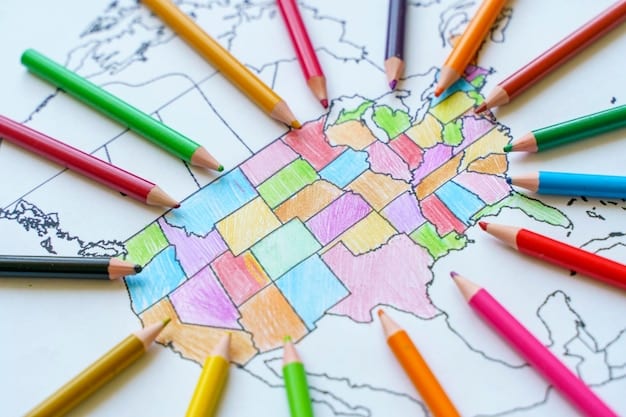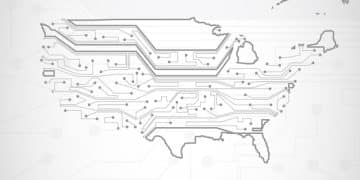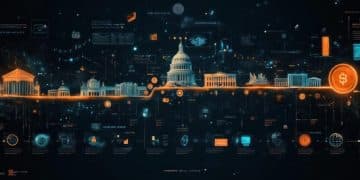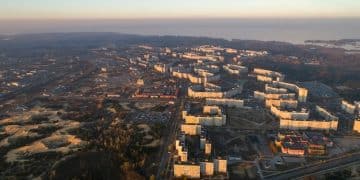State Redistricting: Analyzing the Impact of New Maps on Political Representation

State redistricting involves redrawing electoral district boundaries, significantly impacting political representation by influencing which communities are grouped together, potentially altering the outcomes of elections and the balance of power.
State redistricting: How will new maps impact political representation? This crucial process can reshape political landscapes, influencing everything from local elections to the balance of power in state legislatures. Understanding redistricting is essential for grasping the dynamics of American politics.
Understanding State Redistricting: A Primer
State redistricting is the process of redrawing electoral district boundaries. This happens periodically, typically after the decennial census, to account for population shifts and ensure each district represents a roughly equal number of people. But how exactly does this impact political representation?
The way districts are drawn can significantly influence which communities are grouped together, the demographics within those districts, and ultimately, the outcomes of elections. Let’s delve into the core principles and procedures of state redistricting.
The Basics of Redistricting
Redistricting is mandated by the U.S. Constitution to ensure fair representation. However, the specifics of how it’s carried out vary from state to state. Here are some key aspects to keep in mind:
- One Person, One Vote: The principle of “one person, one vote” requires that each district has roughly the same number of residents, ensuring equal representation.
- Frequency: Redistricting typically occurs every ten years following the U.S. Census, which provides updated population data.
- Responsibility: In most states, the state legislature is responsible for drawing the new maps, although some states use independent commissions.
The process can become highly political, with different parties vying to create districts that favor their candidates. This is where the concept of gerrymandering comes into play.

Gerrymandering: When Redistricting Goes Wrong
Gerrymandering is the practice of drawing district lines to benefit one political party or group over another. This can result in oddly shaped districts that seem to defy logic, all in the name of political advantage.
There are two primary techniques used in gerrymandering:
- Cracking: Splitting up concentrations of opposition voters across multiple districts to dilute their voting power.
- Packing: Concentrating opposition voters into a single district to reduce their influence in surrounding districts.
- Stacking: Concentrating or diluting minority voting power.
The results of gerrymandering can be significant, leading to skewed election outcomes and a lack of competitive races. This can undermine the principles of democracy and fair representation.
Understanding the mechanics and potential pitfalls of state redistricting is the first step in assessing its impact on political representation.
The Impact on Representation: Who Wins, Who Loses?
Redistricting can have a profound impact on who gets elected and which communities have their voices heard. New maps can shift the balance of power, creating opportunities for some while disenfranchising others.
Let’s explore how redistricting can affect different groups and communities.
Impact on Minority Representation
Redistricting can either bolster or undermine minority representation. Creating majority-minority districts can help ensure that minority groups have a better chance of electing representatives of their choice.
However, if done improperly, redistricting can dilute minority voting power. This can happen through:
- Cracking: Splitting minority communities across multiple districts to prevent them from forming a majority in any one district.
- Packing: Concentrating minority voters into a single district, reducing their influence in surrounding districts.
The Voting Rights Act of 1965 plays a crucial role in protecting minority voting rights during the redistricting process. It prohibits redistricting plans that discriminate against minority voters.
Impact on Political Parties
Redistricting is often a high-stakes political battle, with each party trying to gain an advantage. The party in power often controls the redistricting process, giving them the ability to draw maps that favor their candidates.
This can lead to:
- Incumbent Protection: Drawing districts to protect sitting legislators, regardless of their party affiliation.
- Party Advantage: Creating districts that are heavily skewed towards one party, making it difficult for the other party to compete.
- Increased Polarization: Reducing the number of competitive districts, leading to more partisan representatives who are less likely to compromise.
Ultimately, the impact of redistricting on political representation depends on who controls the process and how they choose to draw the maps. Fair and impartial redistricting can lead to more competitive elections and more representative government.

The Role of Independent Commissions
To address concerns about partisan gerrymandering, some states have turned to independent redistricting commissions. These commissions are designed to be non-partisan and to draw maps that are fair and representative.
Independent commissions vary in their structure and composition, but they typically share some common features:
How Independent Commissions Work
Independent commissions aim to remove or reduce political influence from the redistricting process, some strategies include:
- Non-partisan Composition: Membership is often balanced between Democrats, Republicans, and independents.
- Transparency: Public meetings and hearings are held to gather input from the community.
- Criteria: Commissions are often required to follow specific criteria when drawing maps, such as compactness, contiguity, and respect for communities of interest.
The effectiveness of independent commissions can vary depending on their specific design and the political climate in the state. However, they offer a potential solution to the problem of partisan gerrymandering.
The Impact of Independent Commissions
Studies have shown that independent commissions can lead to:
- More Competitive Districts: Maps drawn by independent commissions tend to have more competitive districts than those drawn by legislatures.
- Fairer Representation: Independent commissions may be more likely to create districts that accurately reflect the demographics of the state.
- Reduced Partisanship: By taking politics out of the process, independent commissions can help reduce polarization and promote more collaborative governance.
However, independent commissions are not without their challenges. They can be difficult to establish, and their decisions can still be challenged in court.
Despite these challenges, independent commissions represent a promising approach to ensuring fair and representative redistricting.
Legal Challenges and the Courts
Redistricting is often the subject of legal challenges, with lawsuits filed over claims of gerrymandering, voter suppression, and violations of the Voting Rights Act. The courts play a crucial role in ensuring that redistricting plans are fair and constitutional.
Let’s examine some of the key legal issues involved in redistricting cases.
Key Legal Issues in Redistricting
Redistricting lawsuits often raise complex legal questions such as:
- Gerrymandering: Plaintiffs may argue that a redistricting plan is an unconstitutional partisan gerrymander, violating the equal protection clause of the Fourteenth Amendment.
- Voting Rights Act: Plaintiffs may argue that a redistricting plan violates Section 2 of the Voting Rights Act by diluting minority voting power.
- One Person, One Vote: Plaintiffs may argue that a redistricting plan violates the principle of “one person, one vote” by creating districts with significant population disparities.
The courts have struggled to develop clear and consistent standards for evaluating gerrymandering claims. However, they continue to play an important role in protecting voting rights and ensuring fair representation.
Landmark Redistricting Cases
Several landmark Supreme Court cases have shaped the legal landscape of redistricting, including:
- Baker v. Carr (1962): Established the principle that redistricting cases are justiciable, meaning that they can be heard in federal court.
- Reynolds v. Sims (1964): Established the “one person, one vote” principle, requiring that legislative districts be roughly equal in population.
- Shaw v. Reno (1993): Raised concerns about the use of race as the predominant factor in drawing district lines.
These cases have helped define the legal limits of redistricting and have provided guidance to lower courts in resolving redistricting disputes.
The courts will continue to play an important role in shaping the redistricting landscape, ensuring that maps are fair, constitutional, and representative of the communities they serve.
The Role of Technology and Data
Technology and data analysis have become increasingly important in the redistricting process. Sophisticated mapping software and demographic data allow mapmakers to create highly targeted districts.
Let’s examine how technology and data are used in redistricting and the potential implications.
How Technology and Data are Used
Technology and data analysis tools have changed redistricting, for example:
- Mapping Software: Geographic Information Systems (GIS) software allows mapmakers to create and manipulate district boundaries with precision.
- Demographic Data: Detailed demographic data from the U.S. Census and other sources is used to analyze the racial, ethnic, and socioeconomic composition of districts.
- Voting Data: Historical voting data is used to predict how different districts will vote in future elections.
These tools can be used for both legitimate purposes, such as ensuring compliance with the Voting Rights Act, and for partisan gerrymandering.
The Implications of Data-Driven Redistricting
The use of technology and data in redistricting raises several important questions:
- Transparency: Should the data and algorithms used in redistricting be made public?
- Fairness: How can we ensure that technology is used to promote fair representation, rather than partisan advantage?
- Access: Do all stakeholders have equal access to the technology and data needed to participate effectively in the redistricting process?
As technology continues to evolve, it will be important to address these questions to ensure that redistricting remains a fair and democratic process.
Technology and data analysis have become essential tools in the redistricting process, offering both opportunities and challenges for ensuring fair and representative government.
The Future of Redistricting Reform
Redistricting reform is a perennial issue in American politics. As concerns about partisan gerrymandering continue to grow, there is increasing interest in finding ways to make the process fairer and more representative.
Let’s explore some of the potential reforms that have been proposed.
Potential Redistricting Reforms
Several different approaches to redistricting reform have been suggested, including:
- Independent Commissions: Establishing independent commissions to draw maps, as discussed earlier in this article.
- Criteria for Drawing Maps: Requiring mapmakers to follow specific criteria, such as compactness, contiguity, and respect for communities of interest.
- Ranked-Choice Voting: Adopting ranked-choice voting, which allows voters to rank candidates in order of preference, potentially reducing the impact of gerrymandering.
Each of these reforms has its own strengths and weaknesses, and the best approach may vary from state to state.
The Challenges of Redistricting Reform
Redistricting reform can be difficult to achieve due to political opposition and legal hurdles. The party in power is often reluctant to give up control over the redistricting process, and any proposed reforms are likely to face legal challenges.
- Political Opposition: Overcoming the resistance of politicians who benefit from the current system.
- Legal Hurdles: Ensuring that any proposed reforms are constitutional.
- Public Awareness: Raising public awareness of the importance of redistricting reform.
Despite these challenges, the growing movement for redistricting reform suggests that change is possible. Fairer and more representative maps can lead to a more responsive and accountable government, ultimately benefiting all citizens.
Redistricting reform remains a crucial issue for ensuring fair and representative government in the United States.
| Key Point | Brief Description |
|---|---|
| 🗳️ Redistricting | Redrawing electoral district boundaries, typically after the census. |
| 🗺️ Gerrymandering | Drawing district lines to favor a political party or group. |
| ⚖️ Legal Challenges | Lawsuits over gerrymandering, voter suppression, and VRA violations. |
| 🤝 Independent Commissions | Non-partisan bodies drawing fairer, more representative maps. |
Frequently Asked Questions
▼
State redistricting involves redrawing electoral district boundaries to account for population changes. It’s crucial because it directly impacts political representation, potentially favoring one party or group over others based on how districts are drawn.
▼
State redistricting typically occurs every ten years, following the completion of the U.S. Census. This ensures that district boundaries are updated to reflect the latest population data and demographic shifts within the state.
▼
Gerrymandering is the practice of drawing district lines to benefit a specific political party or group. It affects elections by creating districts that heavily favor one party, making it difficult for the other party to compete effectively.
▼
Independent commissions are designed to remove political influence from the redistricting process. They aim to create fair and representative maps by following specific criteria and holding public hearings to gather community input.
▼
Courts get involved in state redistricting through legal challenges, such as claims of gerrymandering or violations of the Voting Rights Act. They ensure that redistricting plans are constitutional and protect voting rights for all citizens.
Conclusion
Understanding state redistricting: How will new maps impact political representation? is vital for any informed citizen. As we’ve explored, this process goes far beyond simply redrawing lines on a map. It shapes the very essence of our democracy, influencing who represents us and how our voices are heard. By staying informed and engaged, we can help ensure that redistricting leads to fairer, more representative government.





